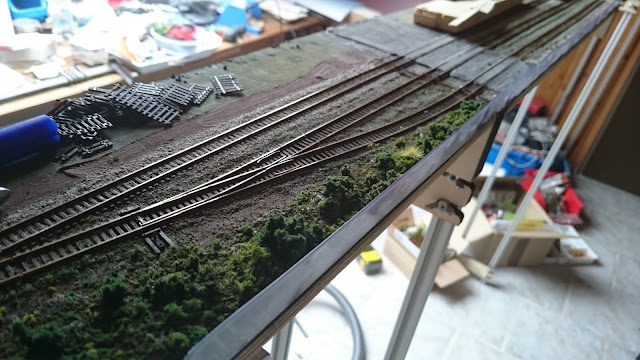Since we bought a house last year, there wasn't much time to spend for my hobby. But if a thought gets you and keeps you thinking of a module and how it can be done, it will be done.
-
Seit dem Hauskauf (Ende letzten Jahres) war die Zeit fürs Hobby leider sehr knapp bemessen. Aber wenn sich eine Idee im Kopf festsetzt und man immer wieder überlegt wie man es umsetzen kann, setzt man es irgendwann um. Der Text bleibt vorerst in Englisch, wenn ich mal Zeit habe folgt auch die deutsche Übersetzung.
-
Seit dem Hauskauf (Ende letzten Jahres) war die Zeit fürs Hobby leider sehr knapp bemessen. Aber wenn sich eine Idee im Kopf festsetzt und man immer wieder überlegt wie man es umsetzen kann, setzt man es irgendwann um. Der Text bleibt vorerst in Englisch, wenn ich mal Zeit habe folgt auch die deutsche Übersetzung.
After spending our 2014 summer holidays in Canda (Ontario and Quebec) I changed my modeling location from Californias west coast to St. Lawrence region in east Canda. My locomotive roster of SP Units will be sold or custom painted to new roads. My new home operator will be the Quebec Gatineau Railway (QGRY) (French: Chemins de fer Québec-Gatineau Inc.) a Genesee & Wyoming company. Due to power shortage on the Huron Central Railway (HCRY) and Interchange with the St-Laurent et Atlantique Quebec (SLQ) also some of these units will appear.
During our trip we spent some nights in Trois-Rivières, QC. There I discovered the Kruger Inc. Paper Mill served by the QGRY. Here you can find some holiday pictures...
My first Idea was to build the Papermill warehouse and the storage spurs according to the Fremo-AmericaN Module Standard. This brought me to a transport problem: The Kruger module group should be at least 3m in length and 40cm in width to demonstrate the space. Also it always looks more prototypical to store a few cars with much
space left in the yard then storing 5 cars on a 5 car siding. A transport volume of 60cm * 40cm * 110cm was way to big for a small sized convertible car like mine.
So I changed the track plan and created the scene on 5 TableTop Modules. Each module has a length of 70cm, so the group was even longer then the first plan. The transport volume decreased to three boxes each 74cm * 20cm * 30cm
Trying to push my modeling skills to a higher level I used google street view screenshots and some of my own photos to create realism. Of course - this track plan is compressed and the Rona building moved to the other side of the rails. This was needed because of an easy access to the rails while derrailments or uncoupling. Also the table top standards backdrop of the portable modules helps low profile buildings to look more realistic.
Everything started with building the modules. I went to my local home improvement center and ordered 5 backwalls, 5 front plates and 5 base plates. At home I assembled the modules using the laser cut american tabletop starter kits. Every kit also contained the electric connectors, track PCBs, printed Backdrops etc.
To align all tracks I drew some orientation lines on the olive green painted modules. The paint is necessary, because it protects the wood against the water of the ballast and scenery glue.
The PCB ties exactly match the Atlas turn out System (the space between two tracks).
The Atlas Code 55 tracks were fixed with a thin layer of 100% white glue. When the glue was dry I soldered the tracks to the PCB ties and cut them with the ROCO/Atlas track saw.
I pre soldered all Atlas turn outs and tested the frog connection. I noticed that the throw bars of 80% of the turn outs was very unsteady, so I drilled new holes in the middle of the bar that fixed this issue. The turnouts were glued and connected with the rest of the tracks.
The wiring is very simple. The front rail is always connected to the front socket/plug. The terminal strip at the top at the end/beginning of the module is needed so possibly divide modules in seperate booster districts. There was not enough Space for my favored Blue Point switch machines, so I built some simple mechanical turn out switching machines.
Roads of 1mm balsa wood and paper board mock ups of the buildings demonstrate the future look of the module group.
I weathered the rail with the walters rust painter. After 2-3 Layers it looked perfect!! Keep in mind that the ballast is still missing. Compare with my photos...
I used ASOA ballast for the middle and right track and a little bit brigther Walthers ballast for the left one. The different colours are according to the protoype. QGRY seemed to have done some mow work here.
To recreate the nature of this region along the St. Lawrence I picked up some small branches from our garden, put some moss on it and covered (after appling a layer of spray glue) it with different turf mixtures. I still had some small NOCH conifers that looked like clones. I Cut them into different sizes and put some turf blends over them.
Her is a first photo of the trees and scenery. Many details are still missing (building/road/poles/paint/weathering/...), but this is the right direction...
So far :)













